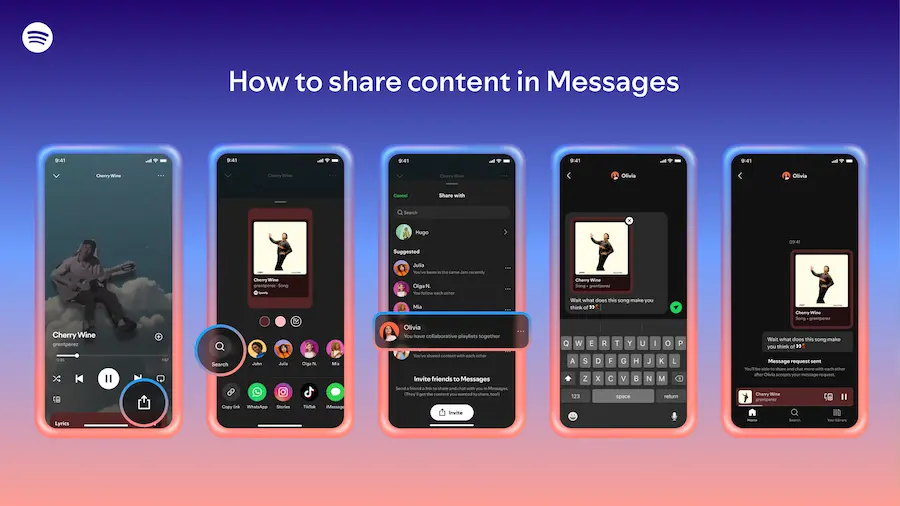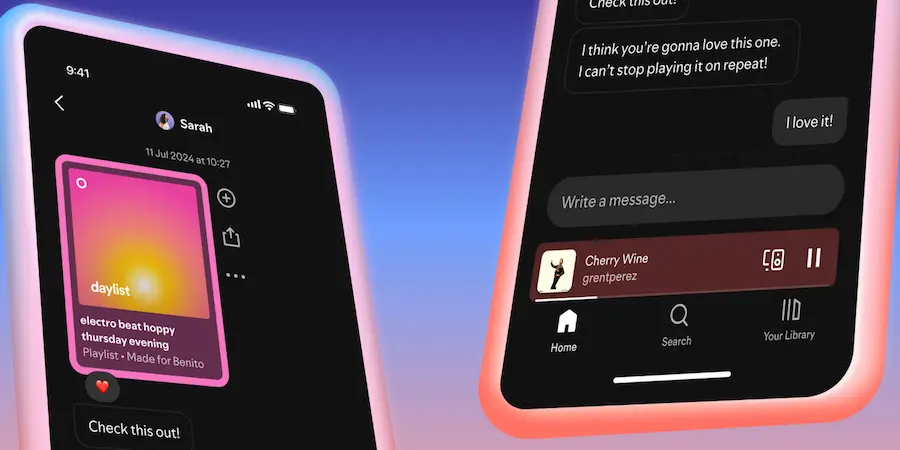Recommendations have always been Spotify’s secret fuel, and now the platform wants to capture that ‘send me that banger’ magic without leaving the app with a native feature: Messages. How many times have you sent a link via WhatsApp to comment on a song or a podcast and the conversation got lost among memes and stickers? With this new feature, Spotify creates a native space to talk about music, podcasts and audiobooks, and keeps everything shared perfectly located, promising smoother conversations and more direct discoveries.
What is Messages and how does it work?
Messages is a one-to-one chat system integrated into Spotify that lets you share platform content and react with text and emojis quickly; in fact its proposition is simple: you hear something you love, tap the share icon in the “Now Playing” view, choose a contact you’ve already interacted with on Spotify and send it, after which that person can accept the request and, from then on, you can both reply, react and keep exchanging tracks without leaving the player. Access is one tap away, from your profile picture in the top-left corner, so it’s as convenient as opening the play queue.
The app will suggest people to start a conversation with based on useful signals, such as if you’ve already shared Spotify content in the past, if you’ve created Blends or collaborative playlists, if you’ve joined Jams, or even if you’re part of the same Family or Duo plan, which speeds up social discovery without having to search for users. Additionally, this system also benefits artists, authors and creators, since it multiplies word-of-mouth recommendations within the ecosystem itself, something that has historically been key to turning curious listeners into loyal fans.
The rollout of Messages starts this week and will arrive gradually to Free and Premium users aged 16 and over, in selected markets and on mobile devices, so although you might not see it in your app yet, the feature will appear over the coming months as Spotify continues refining the experience.

Privacy and control: you’re in charge
Spotify has designed Messages with the user in the driver’s seat, so all conversations begin with a request you can accept or reject, avoiding unwanted contacts from the start; if something ever feels off, you can long-press a message to report it, indicating how it violates the platform’s Rules or the Terms of Use, block the sender and even disable Messages completely from Settings. This “opt-in” and granular control philosophy fits what we expect from a modern service, where we share when we want and with whom we want.
On the security side, Spotify protects conversations with industry-standard encryption both in transit and at rest, which means data is transported and stored protected, and combines this approach with proactive detection of certain illicit or harmful content, plus review by moderators when there are reports — a two-layer approach that aims to keep the environment safer while respecting privacy. Technically, the idea is reminiscent of those security layers we use daily without thinking, like when we sync libraries to the cloud over TLS connections, or when a service applies moderation policies before an incident goes viral.
Does it replace WhatsApp or Instagram? Not at all: it adds to them
Spotify makes it clear that Messages isn’t here to displace your favorite platforms, but to complement them; you can continue sharing content on Instagram, Facebook, WhatsApp, Snapchat, TikTok and company as before, although when you want a channel focused on what’s playing and with an organized history, the in-Spotify chat is the most direct route. In other words, it’s like having a DM stuck to the player, without switching apps or doing copy-and-paste juggling — something multitaskers will appreciate as much as we appreciate having multimedia controls integrated into the keyboard.
This approach has a clear benefit: by keeping the conversation in the same place where you listen, it removes friction and increases the chances that that pending album or that recommended history episode won’t get lost in the ether of links, and it also makes it easier to return to the reference when you feel like it, because everything is grouped by contact. For creators, this social layer amplifies word-of-mouth and can boost the discovery of tracks, episodes or audiobooks, similar to how collaborative playlists or Jam sessions have driven community moments on the platform.
In short, Messages wants to be the catalyst for conversations that were already happening elsewhere, bringing them to the same place where listening originates, and doing so with clear controls and sensible technical safeguards. As the company has pointed out, this is only the beginning, so expect the feature to grow and be refined over the coming months, with iterations that polish usability details and, who knows, new ways of interaction that leverage catalog synergies. If you see music as a “social protocol” — just as RSS democratized subscription to content — this piece fits perfectly into Spotify’s puzzle.

